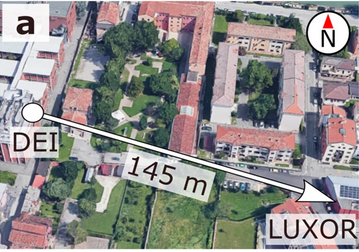
M. Avesani1, L. Calderaro1, M. Schiavon1, A. Stanco1, C. Agnesi1, A. Santamato1, M. Zahidy1, A. Scriminich1, G. Foletto1, G. Contestabile2, M. Chiesa3, D. Rotta3, M. Artiglia4, A. Montanaro4, M. Romagnoli4, V. Sorianello4, F. Vedovato1, G. Vallone1, and P. Villoresi1
npj Quantum Information 7, 93 (2021)
DOI: 10.1038/s41534-021-00421-2
1Department of Information Engineering, University of Padova, via Gradenigo 6/B, 35131 Padova, Italy
2Istituto TeCIP – Scuola Superiore Sant’Anna, Pisa, Italy
3InPhoTec, Integrated Photonic Technologies Foundation, Pisa, Italy
4PNTLab – Consorzio Nazionale Interuniversitario per le Telecomunicazioni, Pisa, Italy
The future envisaged global-scale quantum communication network will comprise various nodes interconnected via optical fibers or free-space channels, depending on the link distance. The free-space segment of such a network should guarantee certain key requirements, such as daytime operation and the compatibility with the complementary telecom-based fiber infrastructure. In addition, space-to-ground links will require the capability of designing light and compact quantum devices to be placed in orbit. For these reasons, investigating available solutions matching all the above requirements is still necessary. Here we present a full prototype for daylight quantum key distribution at 1550 nm exploiting an integrated silicon-photonics chip as state encoder. We tested our prototype in the urban area of Padua (Italy) over a 145m-long free-space link, obtaining a quantum bit error rate around 0.5% and an averaged secret key rate of 30 kbps during a whole sunny day (from 11:00 to 20:00). The developed chip represents a cost-effective solution for portable free-space transmitters and a promising resource to design quantum optical payloads for future satellite missions.
